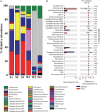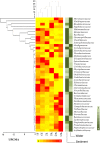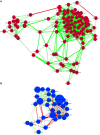Exploration of Microbial Diversity and Community Structure of Lonar Lake: The Only Hypersaline Meteorite Crater Lake within Basalt Rock
- PMID: 26834712
- PMCID: PMC4722114
- DOI: 10.3389/fmicb.2015.01553
Exploration of Microbial Diversity and Community Structure of Lonar Lake: The Only Hypersaline Meteorite Crater Lake within Basalt Rock
Abstract
Lonar Lake is a hypersaline and hyperalkaline soda lake and the only meteorite impact crater in the world situated in basalt rocks. Although culture-dependent studies have been reported, a comprehensive understanding of microbial community composition and structure in Lonar Lake remains elusive. In the present study, microbial community structure associated with Lonar Lake sediment and water samples was investigated using high-throughput sequencing. Microbial diversity analysis revealed the existence of diverse, yet largely consistent communities. Proteobacteria (30%), Actinobacteria (24%), Firmicutes (11%), and Cyanobacteria (5%) predominated in the sequencing survey, whereas Bacteroidetes (1.12%), BD1-5 (0.5%), Nitrospirae (0.41%), and Verrucomicrobia (0.28%) were detected in relatively minor abundances in the Lonar Lake ecosystem. Within the Proteobacteria phylum, the Gammaproteobacteria represented the most abundantly detected class (21-47%) within sediment samples, but only a minor population in the water samples. Proteobacteria and Firmicutes were found at significantly higher abundance (p ≥ 0.05) in sediment samples, whereas members of Actinobacteria, Candidate division TM7 and Cyanobacteria (p ≥ 0.05) were significantly abundant in water samples. Compared to the microbial communities of other hypersaline soda lakes, those of Lonar Lake formed a distinct cluster, suggesting a different microbial community composition and structure. Here we report for the first time, the difference in composition of indigenous microbial communities between the sediment and water samples of Lonar Lake. An improved census of microbial community structure in this Lake ecosystem provides a foundation for exploring microbial biogeochemical cycling and microbial function in hypersaline lake environments.
Keywords: 16S rRNA gene; India; Lonar Lake; basalt rock; microbial diversity; soda lake.
Figures





Similar articles
-
Industrial and Pharmaceutical Applications of Microbial Diversity of Hypersaline Ecology from Lonar Soda Crater.Curr Pharm Biotechnol. 2024;25(12):1564-1584. doi: 10.2174/0113892010265978231109085224. Curr Pharm Biotechnol. 2024. PMID: 38258768 Review.
-
Molecular analyses of microbial diversity associated with the Lonar soda lake in India: an impact crater in a basalt area.Res Microbiol. 2006 Dec;157(10):928-37. doi: 10.1016/j.resmic.2006.08.005. Epub 2006 Oct 9. Res Microbiol. 2006. PMID: 17070674
-
First report on microplastics contamination in a meteorite impact Crater Lake from India.Environ Sci Pollut Res Int. 2023 May;30(23):64755-64770. doi: 10.1007/s11356-023-27074-2. Epub 2023 Apr 20. Environ Sci Pollut Res Int. 2023. PMID: 37079229
-
Novel and unexpected prokaryotic diversity in water and sediments of the alkaline, hypersaline lakes of the Wadi An Natrun, Egypt.Microb Ecol. 2007 Nov;54(4):598-617. doi: 10.1007/s00248-006-9193-y. Epub 2007 Apr 21. Microb Ecol. 2007. PMID: 17450395
-
Microbiology of Lonar Lake and other soda lakes.ISME J. 2013 Mar;7(3):468-76. doi: 10.1038/ismej.2012.137. Epub 2012 Nov 22. ISME J. 2013. PMID: 23178675 Free PMC article. Review.
Cited by
-
Effects of protease and phytase supplements on small intestinal microbiota and amino acid digestibility in broiler chickens.Poult Sci. 2019 Jul 1;98(7):2906-2918. doi: 10.3382/ps/pez038. Poult Sci. 2019. PMID: 30768134 Free PMC article.
-
Changes in Bacteroides and the microbiota in patients with obstructed colorectal cancer: retrospective cohort study.BJS Open. 2023 Nov 1;7(6):zrad105. doi: 10.1093/bjsopen/zrad105. BJS Open. 2023. PMID: 38006331 Free PMC article.
-
Spatial Heterogeneity and Co-occurrence of Mucosal and Luminal Microbiome across Swine Intestinal Tract.Front Microbiol. 2018 Jan 26;9:48. doi: 10.3389/fmicb.2018.00048. eCollection 2018. Front Microbiol. 2018. PMID: 29472900 Free PMC article.
-
Influence of Pelvic Intensity-Modulated Radiation Therapy With Concurrent Cisplatin-Based Chemotherapy of Cervical Cancer on the Vaginal Microbiome.Front Oncol. 2021 Feb 23;11:615439. doi: 10.3389/fonc.2021.615439. eCollection 2021. Front Oncol. 2021. PMID: 33708628 Free PMC article.
-
Oligotrophy vs. copiotrophy in an alkaline and saline habitat of Lonar Lake.Front Microbiol. 2022 Aug 4;13:939984. doi: 10.3389/fmicb.2022.939984. eCollection 2022. Front Microbiol. 2022. PMID: 35992701 Free PMC article.
References
-
- APHA (1998). Standard Methods for the Examination of Water and Waste Water, 20th Edn. Washington, DC: WEF.
-
- Bartram A. K., Lynch M. D., Stearns J. C., Moreno-Hagelsieb G., Neufeld J. D. (2011). Generation of multimillion-sequence 16S rRNA gene libraries from complex microbial communities by assembling paired-end Illumina reads. Appl. Environ. Microbiol. 77, 3846–3852. 10.1128/AEM.02772-10 - DOI - PMC - PubMed
LinkOut - more resources
Full Text Sources
Other Literature Sources

